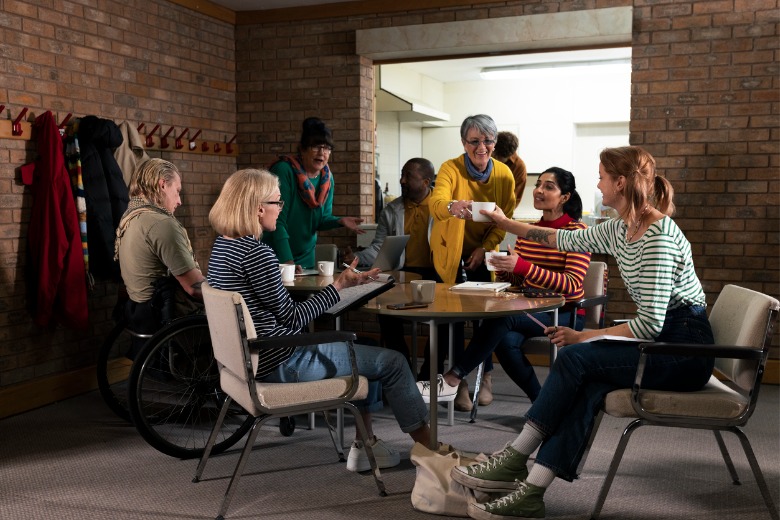
Councils can provide critical social infrastructure by managing neighbourhood centres and running community activities, especially in rapidly growing outer urban areas, a researcher says.

Neighbourhood centres can also provide an access point for building a relationship between local government and the community, according to Dr Ellen van Holstein from RMIT’s Centre for urban research.
Dr Holstein looked at the changing role of local government in Victoria in designing and running community centres in her recent research paper Council-managed neighbourhood centres in Melbourne’s growth areas.
Dr Holstein says while this has traditionally been the role of the state government, councils are increasingly stepping in to plan and run community centres and the programs they offer.
There are about 400 neighbourhood houses in Victoria funded by the state government’s Neighbourhood Houses Coordination Program (NHCP). However, funding doesn’t always make it to new greenfield developments, where demand for community meeting points often outstrips supply.
“In an inner city setting neighbourhood houses have traditionally been managed independently by grassroots community groups with the support of state government funding,” Dr van Holstein tells Government News.
“One of the reasons local councils are stepping in to community centre management in outer suburbs is that the state government has been very slow to take on new neighbourhood houses. This is a relatively new role for local governments.”
Challenges
Dr Holstein says while councils are often hesitant to run community centres on a long-term basis, the research shows they can provide accessible and affordable opportunities for people who would otherwise be vulnerable to loneliness and isolation, such as older residents and migrants.
But there are also challenges, including the large administrative burden that councils can face around issues like insurance.
The report looks at two case studies, one in the City of Wyndham and one referred to as the City of “Rosebush” for the purpose of anonymity.
The Wyndham centre is colocated with a library, a day-care centre, youth services, and consulting rooms for child and maternal health nurses, and has community activity rooms and a meeting room. It hosts a volunteer-run coffee club, a quilting group and a group for senior Indian men.
The ‘Rosebush’ centre offers a program of activities covering leisure, education and health. The building has two community activity rooms and a shared lounge and kitchen area and offers sewing classes, seniors yoga, playgroup and an Arabic group.
In both cases the initial intention was for there to be a transition to (community management) but in both cases transitioning out of that role proved very difficult.
Dr Ellen van Holstein
The councils originally intended for their management of the centres to remain temporary, but in both cases things didn’t work out that way, Dr Holstein says.
“In both cases the initial intention was for there to be a transition to (community management) but in both cases transitioning out of that role proved very difficult,” she said.
“If the local government stepped away then the community centre would fall over, and that created a reputational risk because it can be viewed by people that they are losing local government service offerings.”
The report makes seven recommendations, including that if a council does set up a neighbourhood house or community centre, it should do so with a long-term management vision.
It also recommends councils should look at providing better support for community volunteers, appropriate budgeting for program development and ways of minimising administrative burdens.
Beyond the ‘hall for hire’ model
As urban growth accelerates and infrastructure continues to lag behind growth, it’s highly likely that councils will continue to be involved in managing Victoria’s neighbourhood houses in the foreseeable future, the report concludes.
Dr Holstein says she would like to see local government taking on the job.
“I think in the absence of a willingness by the state government to expand the program there’s a real need for these things and it’s a role local government can really excel in,” she says.
“It would be good if local government could be more confident that there’s a role for them above the ‘hall for hire’ model where no individual party has any responsibility for overseeing the overall program.
“Local government really does an important role to play in managing these centres, and that’s where the core of responsibility should lie – in maintaining a broad accessibility and diversity of offering.”
There are also benefits for councils, she says.
“In some centres people had a really strong sense that the centre was local government place and a local government-led set of programs, so it gave people a really positive view of who their local government is and what they do, and people saw their local government as a generous organisation.
“It also offers a low threshold access point to build a relationship with the community and point people in the direction of other council services. Local government can gain a lot in making these investments.”
Comment below to have your say on this story.
If you have a news story or tip-off, get in touch at editorial@governmentnews.com.au.
Sign up to the Government News newsletter
While this sounds great and in years past it would have been more sutabe the advent of heightened corruption especially in local government it really is no longer of honest real benifit. it works to allow enlightened negative corrections between big business and local communities that are truly of disbenefit to the community especially where honest open debates is required.